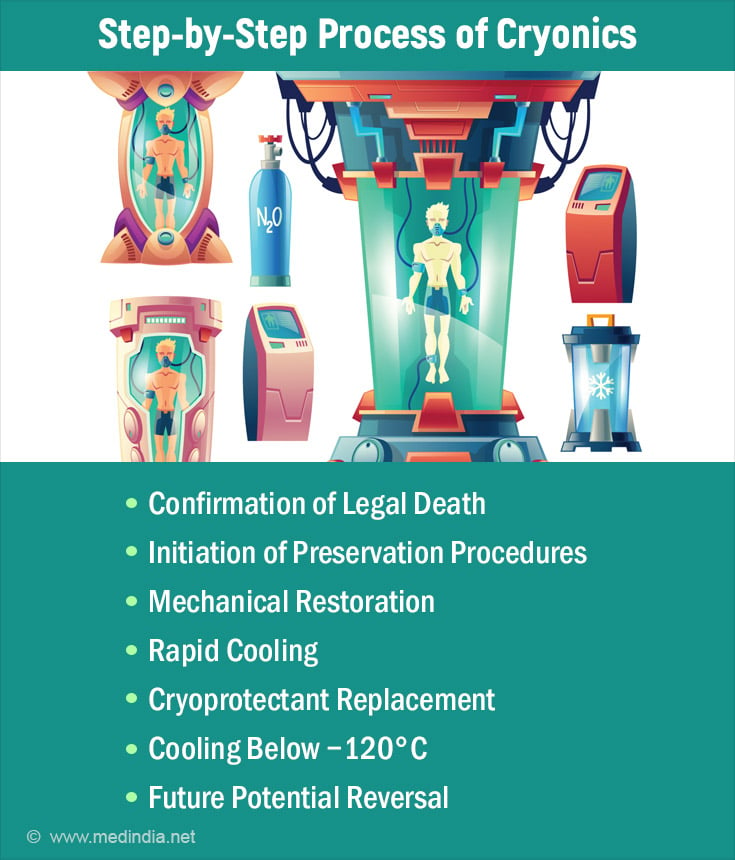- Scientific Justification of Cryonics Practice - (https://www.ncbi.nlm.nih.gov/pmc/articles/PMC4733321/)
- Spending eternity in liquid nitrogen - (https://www.ncbi.nlm.nih.gov/pmc/articles/PMC3328517/)
About
Cryonics is the process of freezing and storing human remains at low temperatures in the hope that they can be brought back to life in the future. This process involves draining the patient's fluids and replacing them with a vitrification solution, cooling the body, and preserving it in liquid nitrogen at -196°C. While it may sound like a concept from science fiction, cryonics is grounded in scientific principles and emerging technologies. This intriguing field stands at the intersection of science and speculation, offering a potential bridge between the present and a future where death might not be the final frontier.
Did You Know?
Pets in the freezer, not just humans! Around 100 beloved pets like dogs, cats, and even birds have undergone cryopreservation alongside their owners.In Arizona lies a facility that challenges the boundaries of life and death. Here, almost 200 humans and nearly 100 beloved pets are suspended in a state of cryopreservation, their bodies preserved in liquid nitrogen-filled tanks, awaiting a future where technology may grant them a second chance at life.At its core, cryonics stands at the intersection of science and speculation. The journey begins with the declaration of legal death, marking the commencement of a delicate process aimed at preserving cellular integrity and preventing irreversible damage. Cryopreservation, far from a simple act of freezing, involves a series of meticulous steps designed to safeguard cellular structures.
Mechanical CPR devices maintain blood circulation, while a specialized cocktail of medications shields cells from harm. The ultimate objective is not mere freezing but vitrification-a process that transforms biological tissue into a glass-like state, preserving it in suspended animation until a time when medical science may offer a remedy.
Science Behind Cryonics Scientific Foundations of Cryonics
Cryonics, often viewed as a fantastical concept, finds its roots in scientific principles and emerging technologies. The rationale behind cryonics is anchored in three fundamental facts:
- Life Preservation through Structure: Life can be halted and restarted if its essential structure is preserved. Insights from biology demonstrate that life is a specific arrangement of matter, capable of resuming function if cellular structure and chemistry are sufficiently preserved.
- Vitrification for Structural Preservation: Vitrification, the process of transforming tissue into a glass-like state, allows for excellent structural preservation without the formation of damaging ice crystals. This technique offers a promising avenue for preserving vital biological structures.
- Foreseeable Technological Advances: Emerging fields like nanotechnology hold the promise of extensive tissue repair and regeneration at the molecular level. Future advancements in medical science could potentially reverse damage incurred during the preservation process, paving the way for revival.
Scientific Rationale Behind Cryonics
Very low temperatures, achieved through cryopreservation, can create conditions conducive to preserving tissue for centuries, potentially including the neurological basis of the human mind. The process of vitrification, in particular, allows for brain tissue to be cooled to cryogenic temperatures without the formation of damaging ice crystals.
The justification for cryonics rests on several foundational principles. Firstly, low temperatures can significantly slow metabolic processes, effectively halting chemical changes for extended periods. Secondly, the use of vitrification mixtures can minimize or eliminate ice formation, preserving tissue integrity. Thirdly, the concept of legal death does not equate to irreversible death, as the process of dying unfolds over a longer timeframe than commonly assumed. Lastly, damage incurred during cryopreservation and clinical death, which may be irreversible with current technology, holds the potential for future reversibility.
Procedure of Cryonics
The cryonics process commences following the pronouncement of legal death, as cryonics is not yet established as a recognized medical procedure. Once legal death is confirmed, a cryonics team initiates preservation procedures immediately. These procedures are designed to safeguard tissue integrity while cooling the subject to temperatures below −120°C, minimizing structural alterations post-cardiac arrest.
During the initial stage of cryopreservation, mechanical restoration of circulation and respiration is performed, along with the administration of protective medications. The subject is rapidly cooled to temperatures between 10°C and 0°C, and blood is replaced with a cryoprotectant mixture to prevent ice formation. Subsequently, the subject is cooled below −120°C and placed in cryostasis.
In the envisioned future of cryonics, advancements in medical science may enable the reversal of the cryopreservation process. Upon re-warming, cryoprotectants would be removed, tissues repaired, diseases cured, and rejuvenation administered if necessary. This speculative future underscores the aspirational nature of cryonics, grounded in the hope for transformative medical breakthroughs(1✔ ✔Trusted Source
Scientific Justification of Cryonics Practice
Go to source).

Challenges and Limitations of Cryonics
While cryonics holds promise, it faces significant technical challenges. Freezing biological tissue without forming ice crystals is a complex endeavor. Ice crystal formation can cause cellular damage, jeopardizing the integrity of preserved tissues. Overcoming this hurdle requires precise control over cooling rates and the use of cryoprotectants to minimize ice formation.
Ethical concerns also loom large in the realm of cryonics. The issue of informed consent is paramount-can individuals truly consent to a procedure with an uncertain outcome? The decision to undergo cryopreservation often involves profound existential questions and may raise ethical dilemmas regarding autonomy and dignity.
Additionally, the long-term viability of cryonics organizations raises questions. Can these facilities guarantee their services for centuries? Maintenance of cryopreservation facilities, financial sustainability, and societal acceptance are ongoing challenges that cryonics organizations must navigate.
Legal and Ethical Considerations of Cryonics
The Legal Landscape of Cryonics
From a legal standpoint, cryonics occupies a unique position. It is not yet classified as a medical treatment but rather as a form of preservation. As such, specific regulations governing cryonics practices vary across jurisdictions. Legal frameworks often focus on issues such as informed consent, property rights over cryopreserved bodies, and the responsibilities of cryonics organizations.
Did You Know?
The 'Iceman' Inspiration: The discovery of Ötzi, the well-preserved 5,300-year-old mummy, fueled speculation about the potential for cryonics. While not frozen intentionally, Ötzi's body offers a glimpse at long-term cellular preservation.Cryonics Enthusiasts and Ethical Considerations
Cryonics enthusiasts are careful to distinguish their practice from merely freezing corpses, preferring the term "deanimated" over "dead." This distinction reflects their belief that cryonics offers not an end but a potential continuation of life, pending future scientific advancements.
Despite the inherent appeal of the idea, the number of individuals who have undergone cryopreservation remains small, with only about 250 documented cases according to the Cryonics Institute. However, interest in the procedure is more widespread, with close to 2000 members enrolled in the two major cryonics providers in the United States.
Central to the cryonics philosophy is the contention that death is not an absolute state but rather a process that can be paused indefinitely through preservation techniques. Cryonicists argue that the moment of clinical death, as determined by medical professionals, does not necessarily mark the point of irreversible demise. Instead, it represents an opportunity to halt biological processes until such time as technology advances sufficiently to revive and treat the individual.
While cryonicists acknowledge the speculative nature of their endeavor, they remain optimistic about the future possibilities. They concede uncertainty regarding the level of scientific progress required to reanimate preserved individuals and the timeline for achieving such advancements. Some envision breakthroughs in molecular nanotechnology or cyber-solutions like "mind uploading" as potential avenues for reversing the effects of cryopreservation.
The cryonics process involves replacing bodily fluids with a vitrification solution to prevent ice crystal formation and preserve tissue integrity. Despite the physical damage caused by storing bodies at extremely low temperatures and the use of toxic chemicals, cryonicists hold out hope that future scientific discoveries will mitigate these effects.
Central to the cryonics debate is the question of legality and ethics. Cryopreservation can only be performed on individuals who have been pronounced dead by qualified medical professionals, necessitating a clear distinction between clinical and "biological" death. While cryonicists advocate for the legality of their practice, some jurisdictions impose restrictions on the marketing and sale of cryonics arrangements.
In Canada, for example, provincial legislation in British Columbia places limits on the promotion of cryonics services under the Cremation, Internment and Funeral Services Act. Despite these legal constraints, individuals interested in cryonics can still make arrangements with providers abroad, highlighting the complex interplay between legal frameworks and personal choices in matters of end-of-life care(2✔ ✔Trusted Source
Spending eternity in liquid nitrogen
Go to source).
Did You Know?
Nano Repair Dreams: Proponents of cryonics believe future advancements in nanotechnology could allow for repairs at the molecular level, potentially reversing damage sustained during the freezing process.Cryonics Today and Future Prospects
Since the inception of cryonics in 1967, over a hundred individuals have undergone cryopreservation. Organizations like Al-cor have pioneered advancements in preservation techniques, aiming to push the boundaries of what is scientifically achievable. The process ideally begins immediately following cardiac arrest, with a focus on preserving brain function by contemporary standards.
The future trajectory of cryonics is poised for expansion and refinement. Efforts are underway to extend vitrification techniques beyond the brain to encompass the entire human body. Additionally, ongoing research endeavors seek to minimize biochemical alterations during the preservation process, inching closer to demonstrable reversibility.
Beyond human revival, cryonics holds potential for diverse applications. Preservation of endangered species' genetic material could aid conservation efforts, allowing scientists to revive extinct species or bolster dwindling populations. Furthermore, cryonics may revolutionize organ transplantation by extending the viability of donor organs, addressing the critical shortage of available organs for transplantation.
Did You Know?
Brain vs. Body: Some cryonics organizations offer a "neuro" option, where only the head is preserved. This is based on the idea that future technology might be able to grow a new body or transfer a consciousness into a machine.Debates and Perspectives of Cryonics
While cryonics offers a glimmer of hope to its proponents, it remains a subject of debate and skepticism within the scientific community. Critics like Dr. Arthur Caplan dismiss cryonics as a far-fetched notion divorced from reality, citing logistical and ethical concerns. However, advocates like Natasha Vita-More envision a future where cryonics transcends mortality, offering the promise of reunion with loved ones and rejuvenation through medical advancements.
As the discourse continues, the patients of Alcor remain suspended in a state of limbo, their fate entwined with the march of scientific progress. For believers, cryonics represents a daring leap into the unknown-a testament to humanity's eternal quest for transcendence.
Summary
In cryonics, hope intertwines with scientific inquiry, offering a glimpse into a future where mortality may be transcended. As research progresses and debates persist, the patients of Alcor remain suspended in a timeless limbo, embodying humanity's enduring quest for immortality. Whether cryonics is a leap of faith or a leap of science, only time will tell.









